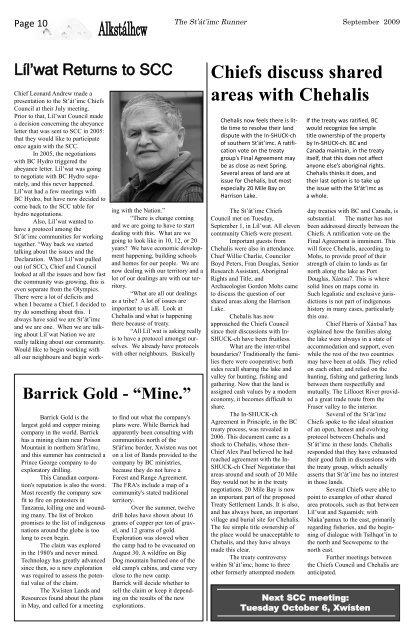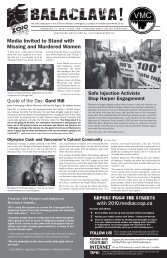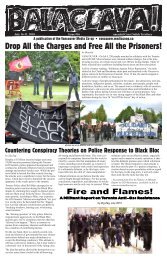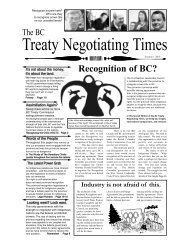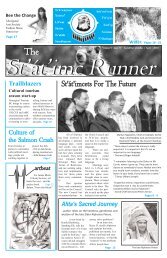St’át’imc Runner
september fp 09_Layout 1 - The Media Co-op
september fp 09_Layout 1 - The Media Co-op
You also want an ePaper? Increase the reach of your titles
YUMPU automatically turns print PDFs into web optimized ePapers that Google loves.
Page 10<br />
Alkstálhcw<br />
The <strong>St’át’imc</strong> <strong>Runner</strong> September 2009<br />
Líl’wat Returns to SCC<br />
Chief Leonard Andrew made a<br />
presentation to the <strong>St’át’imc</strong> Chiefs<br />
Council at their July meeting.<br />
Prior to that, Líl’wat Council made<br />
a decision concerning the abeyance<br />
letter that was sent to SCC in 2005:<br />
that they would like to participate<br />
once again with the SCC.<br />
In 2005, the negotiations<br />
with BC Hydro triggered the<br />
abeyance letter. Líl’wat was going<br />
to negotiate with BC Hydro separately,<br />
and this never happened.<br />
Líl’wat had a few meetings with<br />
BC Hydro, but have now decided to<br />
come back to the SCC table for<br />
hydro negotiations.<br />
Also, Líl’wat wanted to<br />
have a protocol among the<br />
<strong>St’át’imc</strong> communities for working<br />
together. “Way back we started<br />
talking about the issues and the<br />
Declaration. When Líl’wat pulled<br />
out (of SCC), Chief and Council<br />
looked at all the issues and how fast<br />
the community was growing, this is<br />
even separate from the Olympics.<br />
There were a lot of deficits and<br />
when I became a Chief, I decided to<br />
try do something about this. I<br />
always have said we are <strong>St’át’imc</strong><br />
and we are one. When we are talking<br />
about Líl’wat Nation we are<br />
really talking about our community.<br />
Would like to begin working with<br />
all our neighbours and begin working<br />
with the Nation.”<br />
“There is change coming<br />
and we are going to have to start<br />
dealing with this. What are we<br />
going to look like in 10, 12, or 20<br />
years? We have economic development<br />
happening, building schools<br />
and homes for our people. We are<br />
now dealing with our territory and a<br />
lot of our dealings are with our territory.<br />
“What are all our dealings<br />
as a tribe? A lot of issues are<br />
important to us all. Look at<br />
Chehalis and what is happening<br />
there because of treaty.<br />
“All Líl’wat is asking really<br />
is to have a protocol amongst ourselves.<br />
We already have protocols<br />
with other neighbours. Basically<br />
Barrick Gold - “Mine.”<br />
Barrick Gold is the<br />
largest gold and copper mining<br />
company in the world. Barrick<br />
has a mining claim near Poison<br />
Mountain in northern St'át'imc,<br />
and this summer has contracted a<br />
Prince George company to do<br />
exploratory drilling.<br />
This Canadian corporation's<br />
reputation is also the worst.<br />
Most recently the company saw<br />
fit to fire on protesters in<br />
Tanzania, killing one and wounding<br />
many. The list of broken<br />
promises to the list of indigenous<br />
nations around the globe is too<br />
long to even begin.<br />
The claim was explored<br />
in the 1980's and never mined.<br />
Technology has greatly advanced<br />
since then, so a new exploration<br />
was required to assess the potential<br />
value of the claim.<br />
The Xwísten Lands and<br />
Resources found about the plans<br />
in May, and called for a meeting<br />
to find out what the company's<br />
plans were. While Barrick had<br />
apparently been consulting with<br />
communities north of the<br />
St'át'imc border, Xwísten was not<br />
on a list of Bands provided to the<br />
company by BC ministries,<br />
because they do not have a<br />
Forest and Range Agreement.<br />
The FRA's include a map of a<br />
community's stated traditional<br />
territory.<br />
Over the summer, twelve<br />
drill holes have shown about 16<br />
grams of copper per ton of gravel,<br />
and 12 grams of gold.<br />
Exploration was slowed when<br />
the camp had to be evacuated on<br />
August 30. A wildfire on Big<br />
Dog mountain burned one of the<br />
old camp's cabins, and came very<br />
close to the new camp.<br />
Barrick will decide whether to<br />
sell the claim or keep it depending<br />
on the results of the new<br />
explorations.<br />
Chiefs discuss shared<br />
areas with Chehalis<br />
Chehalis now feels there is little<br />
time to resolve their land<br />
dispute with the In-SHUCK-ch<br />
of southern <strong>St’át’imc</strong>. A ratification<br />
vote on the treaty<br />
group’s Final Agreement may<br />
be as close as next Spring.<br />
Several areas of land are at<br />
issue for Chehalis, but most<br />
especially 20 Mile Bay on<br />
Harrison Lake.<br />
The <strong>St’át’imc</strong> Chiefs<br />
Council met on Tuesday,<br />
September 1, in Líl’wat. All eleven<br />
community Chiefs were present.<br />
Important guests from<br />
Chehalis were also in attendance.<br />
Chief Willie Charlie, Councilor<br />
Boyd Peters, Fran Douglas, Senior<br />
Research Assistant, Aboriginal<br />
Rights and Title, and<br />
Archaeologist Gordon Mohs came<br />
to discuss the question of our<br />
shared areas along the Harrison<br />
Lake.<br />
Chehalis has now<br />
approached the Chiefs Council<br />
since their discussions with In-<br />
SHUCK-ch have been fruitless.<br />
What are the inter-tribal<br />
boundaries? Traditionally the families<br />
there were cooperative; both<br />
sides recall sharing the lake and<br />
valley for hunting, fishing and<br />
gathering. Now that the land is<br />
assigned cash values by a modern<br />
economy, it becomes difficult to<br />
share.<br />
The In-SHUCK-ch<br />
Agreement in Principle, in the BC<br />
treaty process, was revealed in<br />
2006. This document came as a<br />
shock to Chehalis, whose then-<br />
Chief Alex Paul believed he had<br />
reached agreement with the In-<br />
SHUCK-ch Chief Negotiator that<br />
areas around and south of 20 Mile<br />
Bay would not be in the treaty<br />
negotiations. 20 Mile Bay is now<br />
an important part of the proposed<br />
Treaty Settlement Lands. It is also,<br />
and has always been, an important<br />
village and burial site for Chehalis.<br />
The fee simple title ownership of<br />
the place would be unacceptable to<br />
Chehalis, and they have always<br />
made this clear.<br />
The treaty controversy<br />
within <strong>St’át’imc</strong>, home to three<br />
other formerly attempted modern<br />
If the treaty was ratified, BC<br />
would recognize fee simple<br />
title ownership of the property<br />
by In-SHUCK-ch. BC and<br />
Canada maintain, in the treaty<br />
itself, that this does not affect<br />
anyone else’s aboriginal rights.<br />
Chehalis thinks it does, and<br />
their last option is to take up<br />
the issue with the <strong>St’át’imc</strong> as<br />
a whole.<br />
day treaties with BC and Canada, is<br />
substantial. The matter has not<br />
been addressed directly between the<br />
Chiefs. A ratification vote on the<br />
Final Agreement is imminent. This<br />
will force Chehalis, according to<br />
Mohs, to provide proof of their<br />
strength of claim to lands as far<br />
north along the lake as Port<br />
Douglas, Xáxtsa7. This is where<br />
solid lines on maps come in.<br />
Such legalistic and exclusive jurisdictions<br />
is not part of indigenous<br />
history in many cases, particularly<br />
this one.<br />
Chief Harris of Xáxtsa7 has<br />
explained how the families along<br />
the lake were always in a state of<br />
accommodation and support, even<br />
while the rest of the two countries<br />
may have been at odds. They relied<br />
on each other, and relied on the<br />
hunting, fishing and gathering lands<br />
between them respectfully and<br />
mutually. The Lillooet River provided<br />
a great trade route from the<br />
Fraser valley to the interior.<br />
Several of the <strong>St’át’imc</strong><br />
Chiefs spoke to the ideal situation<br />
of an open, honest and evolving<br />
protocol between Chehalis and<br />
<strong>St’át’imc</strong> in these lands. Chehalis<br />
responded that they have exhausted<br />
their good faith in discussions with<br />
the treaty group, which actually<br />
asserts that <strong>St’át’imc</strong> has no interest<br />
in those lands.<br />
Several Chiefs were able to<br />
point to examples of other shared<br />
area protocols, such as that between<br />
Líl’wat and Squamish; with<br />
Nlaka’pamux to the east, primarily<br />
regarding fisheries, and the beginning<br />
of dialogue with Tsilhqot’in to<br />
the north and Secwepemc to the<br />
north east.<br />
Further meetings between<br />
the Chiefs Council and Chehalis are<br />
anticipated.<br />
Next SCC meeting:<br />
Tuesday October 6, Xwísten


